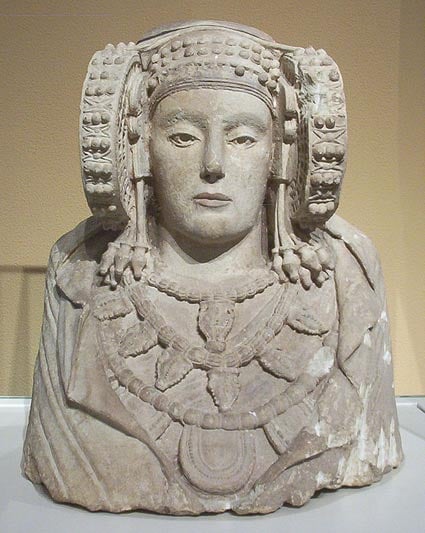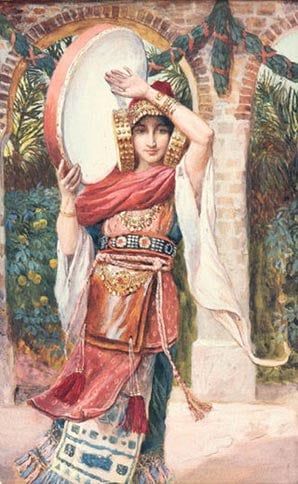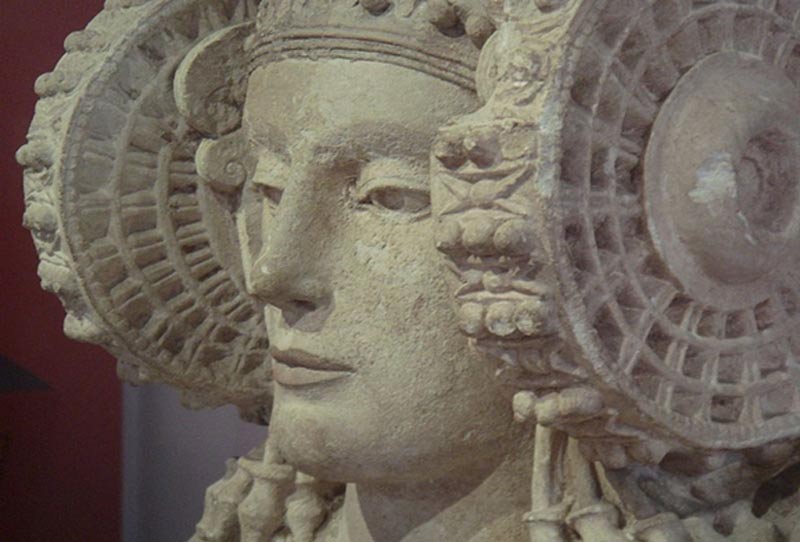The stunning yet mysterious Lady of Elche
In 1897, archaeologists uncovered a stunning artifact on a private estate at L'Alcúdia in Valencia, Spain. This find was a statue – a polychrome bust of a woman’s head. Believed to date back to the 4 th Century BC, the bust features a woman wearing an elaborate headdress. Now seen as one of Spain’s most famous icons, the bust is known as the Lady of Elche.
It is said that a young boy of fourteen had overturned a stone when he came across the bust. The bust shows the woman’s head, neck and shoulders, and extends down to her chest. However, it is possible that the bust was originally part of a larger, full-body statue.
The complex headdress features two large coils known as “rodetes” on either side of the head and face. It is thought that this was a ceremonial headdress, and that the woman may be a priestess. The headdress runs across the forehead, with a pattern of raised marble-shaped bumps. Tassle-like pieces hang in front of the ears, and elaborate necklaces grace her chest. The woman’s face contains an expressionless gaze, and when it was found, contained traces of red, white, and blue decorative paint. The composition of the stone indicates that it was carved at L'Alcúdia.

The Dama de Elche bust. Credit: Luis García (Creative Commons)
The origin of the sculpture is puzzling and has become a matter of heated debate. Some scholars suggest that the sculpture is Iberian, and may be associated with Tanit, the goddess of Carthage, while others have proposed the work reflects an Atlantean Goddess. The unusual features of the sculpture, such as the apparent elongated head and the spools on the side of the head, have also prompted numerous alternative theories to be proposed. For example, according to some independent researchers, the spools are not part of a unique headdress, but are in fact a type of technological headgear that reflects the highly advanced nature of the supposed Atlantis civilization.

Some independent researchers have argued that the woman’s head is elongated and the spools reflect a type of technological headgear.
There are others who argue that the statue doesn’t deserve the attention it receives because it is, in fact, a forgery. Art historian John F. Moffitt argues that the shape of the lady’s eyes and nose are “too delicate to have been carved in pre-Christian Spain.” This argument has been dismissed by many other scholars, who view the bust as a great accomplishment of the early Iberian civilization.

Painting based on the Lady of Elche, ‘Jepthah's Daughter’. James Tissot. (Public Domain)
In 1997, the Mayor of Elche fought to have the bust of the Lady of Elche returned from the National Archaeological Museum of Spain in Madrid to the city of Elche, to be on display during celebrations of the city’s 2000 th year. It was to be a special exhibit, but the petition to have the bust returned was denied. The government commission that denied the request asserted that the bust was too fragile to survive the 250-mile journey from Madrid to Elche. However, others believe that this denial was based upon political motivations. The director of Elche’s archaeology museum, Rafael Ramos argued that it was “preposterous” to say that the statute could not survive the journey, noting that more delicate pieces are transported around the world regularly. His belief is that those in Madrid worry that Elche would not want to return the statue, and that many other cultural relics would be removed from Madrid if the Lady of Elche bust were allowed to be transported. This has created many issues of pride on both a local and regional level. To those in the area, a cultural relic of Elche belongs in Elche.
The disputes and theories regarding the Lady of Elche illustrate the cultural importance of the bust. As a famous ancient icon of Spain, the bust represents Spain’s cultural past. Every Spanish schoolchild learns about the bust and the stories behind the priestess. While the disputes and theories about the bust may continue indefinitely, it is likely hoped by all that the bust will remain safely preserved as a culturally significant symbol of ancient history.
Top image: Detail, the face of the Lady of Elche (Public Domain)
Reources
La Dama de Elche – Source Memory
A Beloved Lady of Spain, Hostage in a Tug-of-War – The New York Times
Lady of Elche – Wikipedia
Lady of Elche – Visit Elche
By M R Reese


















Comments
Almost certainly Atlantean-era/pre Ice Age. The wheels could actually have been a graphic depiction of Atlantis, the concentric-ringed island that existed in the now dry valley of the Richat Structure (Eye of Africa), which was a lush estuary circa 115k BC (adding the zero back to Plato’s timeline). Her nose is NOT smashed, which suggests it was NOT likely seen by anyone in the post-Ice Age modern era prior to its discovery.
Nobody gets paid to tell the truth.
she reminds me Princess Leia.
Abhilasha: I am sorry that you have such poor eyesight. Maybe in your next life your philosophy on life will agree with reality and they your eyesight will be 20/20: JUST SAYING.
Could be a male. I don't find the face feminine at all. Maybe from a certain angle but from front definitely not.
Since I made my initial comment I have begun to research this Dharmachakra wheel and there is no doubt that this image is known in all religions. I am going to research Buddhism and Hinduism symbolism that obviously relates to the wheels that flank the Lady of Elche's head.
The word HEAD in Judaism is exactly what commence the writing of the Judaeo Christian Scripture: i.e which symbolizes the east-west corridor of TIME. The first two letters of Genesis: BETH and RESH writes the first word of Genesis: BE-RESH-ITH. When Resh crosses Beth it is creating the Cross of Christ. Both these letters represent a container. The HEAD houses the psyche. The skull or place of the skull is where Christ died. Creating the word BERESHITH creates the sacred geometry of the VESICA PISCIS, which are the two wheel of the Dharmachakra with the throne of Christ (Merkabah) in the center, which allows the initiate to enter the future on a spiritual level.
Pages